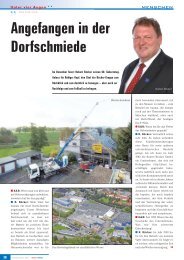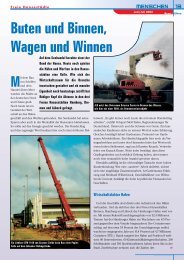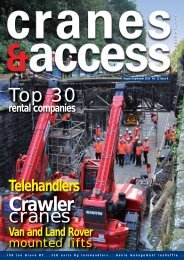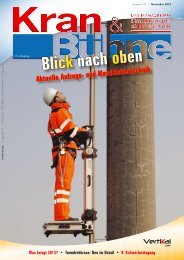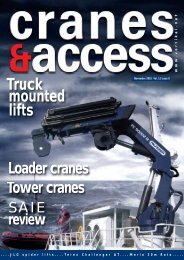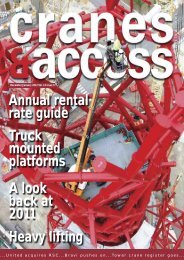Crawler cranes Crawler cranes - Vertikal.net
Crawler cranes Crawler cranes - Vertikal.net
Crawler cranes Crawler cranes - Vertikal.net
Create successful ePaper yourself
Turn your PDF publications into a flip-book with our unique Google optimized e-Paper software.
crawler crane c&a<br />
At the end<br />
of the line<br />
The new Saale-Elster valley viaduct bridge<br />
currently under construction is part of the new<br />
high-speed rail link between Berlin and Munich.<br />
When the line is completed in 2017, the journey<br />
time between the two cities will be cut to less<br />
than four hours. With a total length of 8.89 km -<br />
the main bridge is 6.5km - the viaduct will be<br />
the longest railway bridge in Europe. Structural<br />
work is scheduled for completion in 2012.<br />
The main contractor for the<br />
bridge construction is Himmel<br />
and Papesch together with its<br />
subsidiary company Gerdum and<br />
Breuer. Himmel and Papesch<br />
was founded in 1924 and has<br />
specialised in large bridge<br />
construction ever since.<br />
The new track runs through several<br />
conservation areas as well as a<br />
water pollution control area, making<br />
the construction work particularly<br />
challenging.<br />
"Both the technology required and<br />
the implementation of this<br />
construction project go above and<br />
beyond everyday activity and pose<br />
major challenges on site for all<br />
involved," said Michael Felgner,<br />
project manager with DB<br />
ProjektBau.<br />
The bridge construction is being<br />
started at all three ends - the<br />
viaduct runs roughly east to west<br />
with a spur joining from the north<br />
around a third of the way along<br />
its length - and is largely carried<br />
out using a technique that uses<br />
cantilevered falsework to create<br />
the bridge deck, allowing the<br />
ground and surrounding area to<br />
remain untouched throughout<br />
the construction process.<br />
Three Sennebogen crawler<br />
<strong>cranes</strong> are being used during<br />
the initial bridge construction.<br />
Two 60 tonne capacity<br />
Sennebogen 660 HDs, each with 32<br />
metres of main boom, are positioned<br />
on the north and east abutments,<br />
working on a specially prepared<br />
track on the cantilevered falsework<br />
at a height of almost 20 metres<br />
above the ground. The <strong>cranes</strong> are<br />
used for a wide range of tasks<br />
including inserting 10 and 25<br />
metre long sheet piles for the<br />
foundation of the abutments using<br />
a combination of vibrating and<br />
impact hammers.<br />
34 <strong>cranes</strong> & access December/January 2010<br />
The Sennebogen 660 works on<br />
cantilevered falsework to<br />
carry out a wide variety of tasks<br />
Byzak<br />
The sheet pile boxes are then<br />
excavated and the reinforcement<br />
for the foundations and pylons lifted<br />
into place. The 660s are also used<br />
to place the concrete for the<br />
foundations as well as lifting and<br />
lower the supports as the falsework<br />
is moved forwards.<br />
"A large part of the work at the front<br />
of the cantilevered falsework is<br />
carried out by the Sennebogen<br />
660s," says Ulf Oelze, site<br />
manager for Himmel and Papesch.<br />
Short set-up times make<br />
the Sennebogen 640 a highly<br />
efficient solution for inserting<br />
sheet piles<br />
"We are extremely happy with the<br />
machines - they are reliable,<br />
powerful, highly versatile and their<br />
tremendous stability is a major<br />
advantage when working at this<br />
height.”<br />
The third crane - a Sennebogen 640<br />
HD - is responsible for the guide-free<br />
insertion of sheet piles weighing<br />
up to four tonnes outside the<br />
cantilevered falsework. In one<br />
section, the sheet pile foundations<br />
had to be built in a lake which<br />
required the crane to be positioned on<br />
a hydraulically-supported pontoon.<br />
“The size of this construction site<br />
means that the <strong>cranes</strong> have to be<br />
moved frequently. Thanks to the<br />
short set-up times and the fact that<br />
it can be assembled and dismantled<br />
without additional lifting equipment,<br />
the 640 has reduced our costs and<br />
is extremely efficient,” explains<br />
Oelze. “The elevating cab offers<br />
improved views and coupled with the<br />
outstanding handling of the machine<br />
means the <strong>cranes</strong> are particularly<br />
popular among our operators.”<br />
In the UK, Trentham, Stoke-on-Trentbased<br />
EH Hassell has been the<br />
distributor for Sennebogen <strong>cranes</strong><br />
since 1998 and has chalked up<br />
more than 100 sales. Customers<br />
have included companies such as<br />
Morgan Est which runs an 18 strong<br />
Sennebogen crane fleet which<br />
includes Heavy Duty, lattice and<br />
telescopic boomed units. Other<br />
multiple Sennebogen crane owners<br />
include Carillion, Byzak, Barhale<br />
Construction, Fussey Piling, CBI<br />
John Brown and Weldex. The latest<br />
deliveries include an 80 tonne<br />
capacity 680 HD to Byzak, an 80<br />
tonne 683HD to Weldex and a 140<br />
tonne 4400 to Carrillion.





